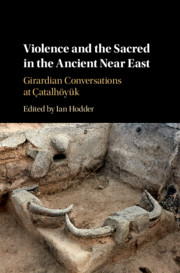Book contents
- Violence and the Sacred in the Ancient Near East
- Frontispiece
- Violence and the Sacred in the Ancient Near East
- Copyright page
- Contents
- Figures
- Tables
- Contributors
- Preface
- Part I Introduction
- Part II Violence and the Sacred
- 3 Death in Çatalhöyük
- 4 A Girardian Framework for Violent Injuries at Neolithic Çatalhöyük in Their Western Asian Context
- 5 Ritual Practices and Conflict Mitigation at Early Neolithic Körtik Tepe and Göbekli Tepe, Upper Mesopotamia
- 6 Paired Leopards and Encircled Prey
- Part III The Dialectics of Mimesis
- Part IV Conclusion
- Index
- References
4 - A Girardian Framework for Violent Injuries at Neolithic Çatalhöyük in Their Western Asian Context
from Part II - Violence and the Sacred
Published online by Cambridge University Press: 04 March 2019
- Violence and the Sacred in the Ancient Near East
- Frontispiece
- Violence and the Sacred in the Ancient Near East
- Copyright page
- Contents
- Figures
- Tables
- Contributors
- Preface
- Part I Introduction
- Part II Violence and the Sacred
- 3 Death in Çatalhöyük
- 4 A Girardian Framework for Violent Injuries at Neolithic Çatalhöyük in Their Western Asian Context
- 5 Ritual Practices and Conflict Mitigation at Early Neolithic Körtik Tepe and Göbekli Tepe, Upper Mesopotamia
- 6 Paired Leopards and Encircled Prey
- Part III The Dialectics of Mimesis
- Part IV Conclusion
- Index
- References
- Type
- Chapter
- Information
- Violence and the Sacred in the Ancient Near EastGirardian Conversations at Çatalhöyük, pp. 60 - 95Publisher: Cambridge University PressPrint publication year: 2019
References
- 1
- Cited by



